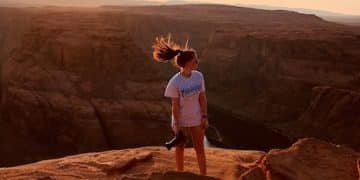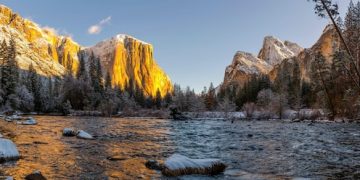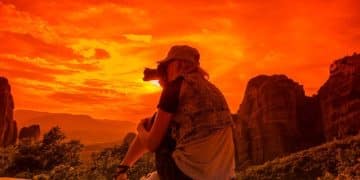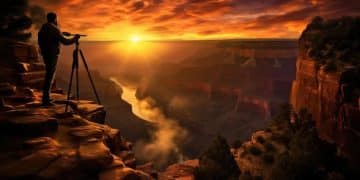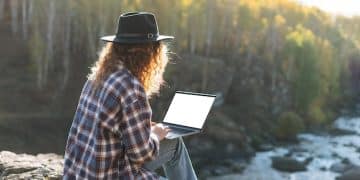Master Travel Photo Composition in 3 Months (2025 Guide)
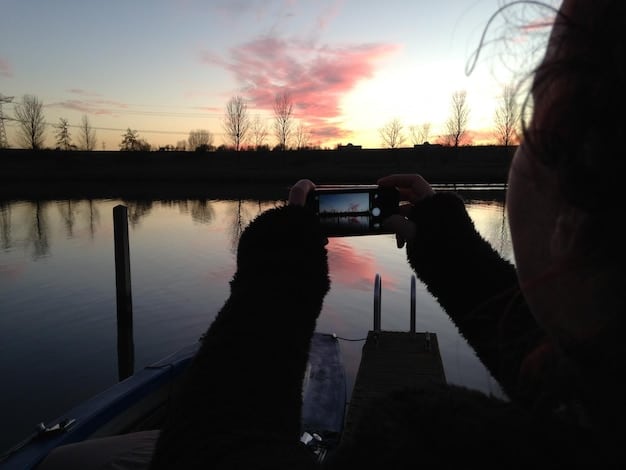
Mastering travel photography composition in just three months for 2025 involves a structured approach integrating foundational principles like the rule of thirds and leading lines with practical application through consistent shooting and critical self-evaluation.
Embarking on the journey to master travel photography composition in 3 months: a beginner’s guide for 2025 is an exciting prospect, transforming how you capture the world. This comprehensive guide is designed to equip you with the essential techniques and practical exercises needed to elevate your travel photos from snapshots to stunning visual stories, setting you on a path to impressive visual artistry by early 2025.
Understanding the DNA of a Compelling Travel Photo
The foundation of any captivating travel photograph lies not just in the subject itself, but in how that subject is arranged within the frame. Composition is the art of organizing elements in your scene to create a visually appealing image that tells a story, evokes emotion, or simply guides the viewer’s eye. It’s about more than just pointing and shooting; it’s about thoughtful arrangement and deliberate choices that transform a mere observation into a work of art.
For beginners, grasping these fundamental principles is the crucial first step. Without a solid understanding of basic compositional rules, even the most exotic locations can result in flat, uninspired images. This initial phase requires a shift in perspective, training your eye to see beyond the obvious and to recognize the inherent visual structures within a scene. It’s about learning to deconstruct what makes a photograph “work” and then applying those insights proactively.
The rule of thirds and off-center placement
One of the most universally recognized compositional guidelines is the Rule of Thirds. Imagine dividing your frame into nine equal sections using two equally spaced horizontal lines and two equally spaced vertical lines. The Rule of Thirds suggests placing your subject or points of interest along these lines or at their intersections. This often creates a more balanced and dynamic image than simply centering your subject.
- Utilize grid lines on your camera or smartphone for easy reference.
- Experiment with placing horizons on the top or bottom third, depending on what you want to emphasize.
- Position key elements at intersections for maximum visual impact.
Leading lines and their narrative power
Leading lines are powerful compositional tools that draw the viewer’s eye through the photograph, leading them directly to your main subject or guiding them through the scene. These can be actual lines, like roads, fences, or rivers, or implied lines, such as a row of lights or a path of footsteps. They are essential for creating depth and a sense of movement within a static image.
Understanding how light interacts with your scene is also critical. Natural light changes throughout the day, offering different moods and opportunities for dramatic compositions. The ‘golden hour’ (shortly after sunrise and before sunset) casts a soft, warm glow that is incredibly flattering for almost any subject, adding depth and dimension. Conversely, harsh midday sun can create strong, unflattering shadows, making careful positioning even more vital.
The beauty of composition is that it’s not a rigid set of rules, but rather a flexible framework to guide your creativity. Once you understand the basics, you can consciously choose to break them for artistic effect. This initial month is about consistent practice and intentional observation, training your eye to see the world through a compositional lens.
Month 1: Building Your Foundational Skills
The first month of your journey is dedicated to internalizing the core principles of travel photography composition. This isn’t just about reading; it’s about actively applying these concepts every time you pick up your camera. Consistent practice is paramount, even if it’s just practicing around your neighborhood or local park. The goal is to make these compositional elements second nature, so you can instinctively identify opportunities for strong compositions.
Start by focusing on a few key techniques and master them before moving on. Overwhelming yourself with too many rules will hinder your progress. Instead, pick two or three compositional tools and dedicate your daily practice to finding and exploiting them in real-world scenarios. This focused approach allows for deeper understanding and faster skill acquisition.
Practical exercise: The rule of thirds challenge
Dedicate a full week to practicing the Rule of Thirds. For every photograph you take, consciously think about where you are placing your subject or horizon lines. Review your images afterward, paying attention to how off-center placement impacts the overall feel of the photo. Use your camera’s grid overlay to aid in this exercise.
- Take at least 5-10 photos daily with the Rule of Thirds in mind.
- Analyze your photos: Do they feel more balanced? Is the viewer’s eye drawn effectively?
- Don’t be afraid to crop in post-processing to refine your composition initially.
Discovering leading lines and framing in context
For the second week, shift your focus to leading lines and natural framing. Look for elements in your environment that can act as lines to guide the eye – roads, fences, rivers, architectural features. For framing, search for natural “frames” within the scene, such as doorways, windows, tree branches, or arches, to enclose your subject and draw attention to it.
Beyond these specific techniques, actively seek out ways to simplify your compositions. Often, less is more. Identify distractions in your frame and find ways to eliminate them, either by changing your angle, getting closer, or using a wider aperture to blur the background. A clean composition allows your main subject to truly shine, preventing visual clutter that can overwhelm the viewer. Remember, a compelling composition often tells a clear, concise story.
Towards the end of Month 1, introduce a habit of critical self-evaluation. After each shooting session, take time to review your images. Don’t just look for “good” photos; analyze what worked and what didn’t from a compositional standpoint. What could you have done differently? This reflective practice accelerates learning and helps solidify your understanding of compositional principles.
Month 2: Adding Depth and Narrative
With a solid grasp of foundational compositional techniques, Month 2 is about adding layers of complexity and narrative depth to your travel photography. This involves moving beyond static rules and beginning to think about how you can use composition to tell a richer story, evoke emotion, and create a sense of place. It’s about translating your personal experience into a visual language that resonates with others.
This month, you’ll begin to explore how elements within your frame interact with each other and how you can intentionally arrange them to create harmony or tension. This is where your individual artistic voice begins to truly emerge, as you start making more subjective decisions about what to include and exclude from your frame. Experimentation is key during this phase.
Utilizing foreground, middle ground, and background
A common mistake for beginners is to focus solely on the main subject. However, integrating a compelling foreground, middle ground, and background can dramatically enhance the depth and storytelling in your travel photos. A foreground element can draw the viewer’s eye into the scene, the middle ground holds the main subject, and the background provides context, creating a three-dimensional feel often lacking in flat images.
- Actively search for interesting foreground elements that complement your main subject.
- Ensure that foreground elements do not distract from the main subject.
- Consider using a wider angle lens to exaggerate the sense of depth.
Exploring symmetry and patterns
Symmetry and patterns are powerful compositional tools that can create striking and aesthetically pleasing images. Symmetry involves balancing elements on either side of a central axis, often found in architecture, reflections, or natural formations. Patterns, whether repetitive shapes, colors, or textures, can add visual interest and rhythm to your photographs.
The concept of negative space also becomes increasingly important in Month 2. Negative space refers to the empty areas around and between the main subjects of an image. When used effectively, negative space can draw attention to your subject, simplify a cluttered scene, and create a sense of calm or dramatic tension. Learning to “see” and utilize negative space is a sophisticated compositional skill that elevates your photography.
By the end of Month 2, you should be comfortably applying a variety of compositional techniques, not just individually, but in combination. You’ll begin to intuitively analyze a scene before raising your camera, considering multiple compositional approaches simultaneously. Active review of your images, perhaps with a peer or mentor, can provide fresh perspectives and accelerate your compositional growth during this crucial stage.
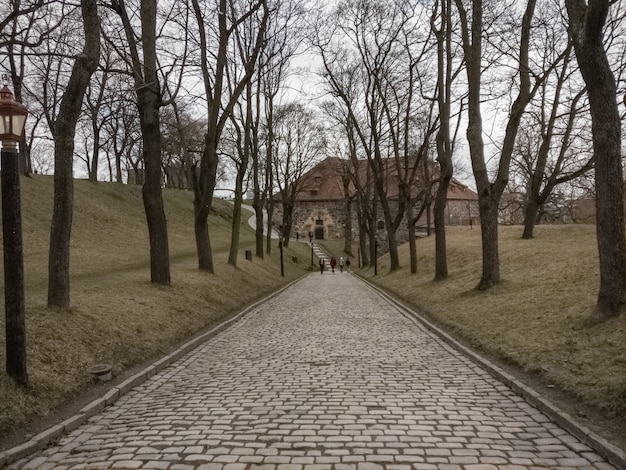
Month 3: Refining Your Eye and Developing Your Style
The final month of this intensive program is dedicated to consolidating your skills, pushing your creative boundaries, and starting to define your unique photographic style. By now, you should be able to consistently identify and apply various compositional techniques. This month is about moving beyond conscious application to an intuitive understanding, where composition becomes an extension of your creative vision.
This is also the time to experiment more boldly. Break the rules you’ve learned to see what works and what doesn’t. Not every creative choice will be a success, but each attempt provides valuable learning. Developing your style means making deliberate artistic choices that reflect your personality and how you see the world, rather than simply mimicking others.
Mastering selective focus and shallow depth of field
While not strictly a compositional rule, selective focus and shallow depth of field are powerful tools for emphasizing your subject and controlling what the viewer sees. By intentionally blurring the background (bokeh), you can isolate your subject, making it stand out from its surroundings. This is particularly effective in travel portraits or when you want to highlight a specific detail in a busy scene.
- Understand the relationship between aperture, focal length, and subject distance for controlling depth of field.
- Practice achieving sharp focus on your main subject while blurring the background.
- Experiment with different levels of background blur to see its impact on the image’s mood.
Storytelling through juxtaposition and emotion
Composition isn’t just about aesthetics; it’s about storytelling. Juxtaposition, placing two contrasting elements side-by-side, can create powerful visual narratives and highlight ironies or unexpected connections. Capturing emotion, whether through expressions or body language, adds another layer of depth, making your travel photos resonate more deeply with viewers.
Consider the role of color in your compositions. Color psychology suggests certain colors evoke different emotions, and understanding how colors interact can enhance the mood and impact of your photos. Look for harmonious color palettes or use a single contrasting color to draw attention to a specific element. Light and shadow also become more sophisticated tools; learn to use them to create drama, define form, and add texture.
Throughout Month 3, critically review the body of work you’ve created. Identify patterns in your stronger images. What compositional elements do they share? What themes or narratives are emerging? This self-analysis is crucial for understanding your evolving style and for identifying areas where you still want to grow. By the end of these three months, you won’t just be taking pictures; you’ll be crafting visual masterpieces.
Advanced Techniques & Breaking the Rules (Sensibly)
Once the fundamental compositional rules become intuitive, the real artistry begins with learning when and how to break them. Breaking a rule without understanding it often leads to a weak photograph. However, intentionally defying a guideline can lead to incredibly striking and original images that challenge viewer expectations.
This stage is about developing your instinct and creative courage. It’s about looking at a scene and asking not just “How can I apply the Rule of Thirds?” but “What if I put the subject dead center and cropped it tightly?” or “What if I intentionally create an unbalanced composition to evoke unease?” This level of deliberate experimentation transforms you from a photographer who follows rules to one who masters them.
Intentional distortion and unique perspectives
Standard compositions often result in standard images. Experiment with unusual perspectives – shooting from very low to the ground, from a high vantage point, or using wide-angle lenses to create intentional distortion. This can add a unique and dynamic quality to your travel photos, offering viewers a fresh way to see a familiar scene. Don’t be afraid to get dirty or look silly to capture that unconventional angle.
- Experiment with shooting through reflections or translucent objects.
- Use a fisheye lens or ultra-wide-angle lens to exaggerate perspective.
- Look for natural frames within frames to add layers of interest.
The power of negative space and minimalism
While often touched upon earlier, truly mastering negative space involves an almost minimalist approach to composition. It means consciously leaving large portions of your frame empty to highlight your subject, create a sense of isolation, or evoke a mood like vastness or serenity. This requires discipline in not filling every inch of the frame and trusting that the empty space itself can contribute to the narrative.
Furthermore, explore the power of repeating elements, but also the deliberate disruption of those repetitions. A series of uniform windows with one broken pane, or a perfect row of trees with one distinctively shaped tree, can create a powerful compositional focal point. These techniques add layers of sophistication, turning simple observations into compelling visual narratives. It’s about seeing the exceptions and highlighting them.
At this advanced stage, critique from others becomes even more valuable. Share your work with experienced photographers or join online communities to receive constructive feedback. Learning to articulate your creative choices and defend your “rule-breaking” compositional decisions is part of the growth process. This continuous loop of creation, critique, and refinement is what separates skilled photographers from true masters.
Post-Processing: Enhancing Your Composition
Composition doesn’t end when you press the shutter button. Post-processing tools, from simple cropping to advanced dodge and burn techniques, offer powerful ways to refine and enhance the compositional choices you made in the field. Think of post-processing as the final layer of polish that amplifies your initial artistic intent. Even minor adjustments can significantly impact the visual flow and impact of your photograph.
While an image with poor initial composition is difficult to save, a well-composed image can be made even stronger with thoughtful editing. Learn to use editing software not just for color correction or exposure adjustments, but specifically for compositional fine-tuning. This includes refining crops, straightening lines, removing distractions, and guiding the viewer’s eye with light and shadow.
Cropping for impact and emphasis
Cropping is perhaps the most direct compositional tool available in post-processing. It allows you to refine your framing, remove distracting elements from the edges of your photograph, and emphasize your main subject. Experiment with different aspect ratios – square crops for intimacy, panoramic for landscapes – to see how they change the image’s dynamic. A seemingly minor crop can often transform a good photo into a great one.
- Always shoot slightly wider than you intend to allow for compositional flexibility in post.
- Use the crop tool to apply the Rule of Thirds or other compositional guidelines if you missed them in-camera.
- Beware of over-cropping, which can degrade image quality or lose important context.
Directing attention with dodging and burning
Dodging (lightening) and burning (darkening) are techniques that allow you to selectively adjust the brightness of specific areas in your photograph. This can be used as a powerful compositional tool to guide the viewer’s eye. Darken distracting areas to push them into the background, or lighten your subject to make it pop and draw immediate attention. This is a subtle but highly effective way to refine your composition digitally.
Understanding how global adjustments like contrast and clarity affect your composition is also important. Increasing contrast can add depth and separation to elements, while clarity can enhance textures and make subjects appear sharper. However, overuse of these tools can make an image look artificial, so moderation is key. The goal is to enhance, not overpower, your initial vision.
Remember that the best post-processing is often subtle and enhances the natural beauty of the image rather than creating something entirely new. Think of it as a sculptor refining a piece of clay – the basic form is there, but the finished work requires careful chiseling and polishing to reveal its true potential. Dedicate time each week to practicing your post-processing skills, specifically with compositional improvement in mind.
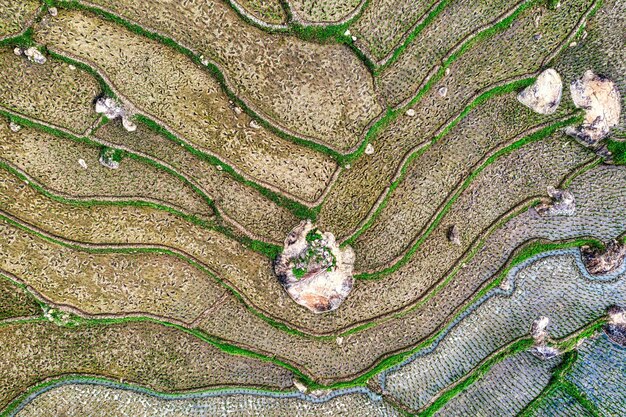
Maintaining Momentum and Continuous Improvement
Mastering travel photography composition isn’t a destination; it’s an ongoing journey. Even after three months of dedicated practice, there will always be new techniques to learn, new ways to see, and new challenges to overcome. The key to long-term growth is to maintain momentum, cultivate a curious mind, and embrace continuous improvement as an integral part of your photographic life.
The world of travel photography is constantly evolving, with new gear, software, and creative trends emerging regularly. Staying engaged with the community, observing the work of others, and actively seeking out new knowledge will keep your skills sharp and your passion alive. Never stop learning, never stop experimenting, and never stop shooting.
Consistent practice and daily visual exercises
Regular practice is non-negotiable. Even a few minutes a day, looking at your surroundings with a compositional eye, can make a difference. Take your camera with you everywhere. Practice “seeing” compositions even when you’re not shooting. This continuous engagement keeps your visual muscles toned and ensures that compositional thinking remains second nature. The more you shoot, the better you become at identifying compelling scenes quickly.
- Carry a small camera or use your smartphone for spontaneous compositional practice.
- Challenge yourself with daily mini-projects focusing on a specific compositional element.
- Analyze photos you admire, deconstructing their compositional choices.
Seek constructive criticism and give back to the community
One of the most powerful tools for growth is constructive criticism. Share your work with trusted peers, join online photography groups, or attend local meetups. Be open to feedback, and learn to discern valuable insights from less helpful comments. Giving back to the community by offering your own thoughtful critiques can also sharpen your eye and deepen your understanding of composition.
Keeping a photography journal can also be incredibly beneficial. Document your observations, your challenges, and your breakthroughs. Note down compositional ideas that come to you, or reflections on why certain photos succeeded or failed. This practice of self-reflection accelerates learning and helps you track your progress over time, reinforcing the growth you’ve achieved. It’s a personal journey, and documenting it adds another layer to your mastery.
Finally, remember to enjoy the process. Photography should be a source of joy and creative expression. Don’t let the pursuit of technical perfection overshadow the simple pleasure of capturing beautiful moments and sharing your unique perspective of the world. Your passion is what will truly drive you to continue mastering travel photography composition for years to come.
| Key Element | Brief Description |
|---|---|
| 🗓️ Month 1 Focus | Mastering basic rules like Rule of Thirds, leading lines, and natural framing. |
| ✨ Month 2 Focus | Adding depth with foreground/background, exploring symmetry, and initial negative space. |
| 🎨 Month 3 Focus | Refining eye with selective focus, storytelling through juxtaposition, developing personal style. |
| 🔄 Continuous Growth | Regular practice, seeking feedback, and embracing advanced techniques and rule-breaking. |
Frequently asked questions about travel photography composition
While true mastery is a lifelong pursuit, you can achieve a strong foundational understanding and significant improvement in your compositional skills within three months of dedicated, consistent practice. This guide provides a structured path to accelerate your learning by focusing on key concepts and practical application.
Absolutely not. Composition is about how you see and arrange elements, not the equipment you use. You can practice and master compositional principles with any camera, even a smartphone. While better gear can offer more flexibility, a creative eye and thoughtful composition will always trump expensive equipment.
For beginners, the Rule of Thirds is arguably the most important foundational rule. It provides a simple yet effective framework for creating balanced and dynamic images, steering you away from repetitive center-weighted compositions. Mastering this rule first provides a solid base for learning more advanced techniques.
Consistency is key. Aim for daily practice, even if it’s just for 15-30 minutes. The objective is to make compositional thinking instinctive. Regular shooting, followed by critical review, will embed these principles into your photographic process much faster than sporadic, long sessions.
Not at all. Post-processing is an integral part of modern photography. Tools like cropping, straightening, and dodging/burning allow you to refine and enhance your initial compositional vision. While good composition starts in-camera, digital darkroom techniques are powerful for perfecting your image and guiding the viewer’s eye.
Conclusion
Mastering travel photography composition is a transformative journey that empowers you to capture the world not just as it is, but as you experience it. By dedicating these next three months to structured learning and persistent practice, focusing on foundational principles, storytelling, and thoughtful refinement, you will undeniably elevate your photographic capabilities. Embrace the process, trust your evolving eye, and prepare to tell richer, more compelling visual stories of your adventures for 2025 and beyond.
